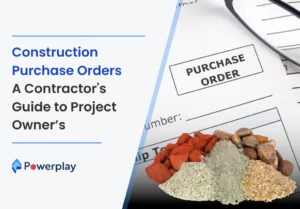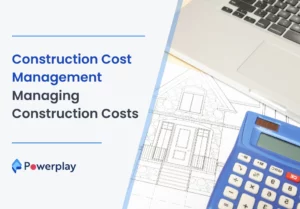The Ultimate Guide to Construction Scheduling
-
Sapna
- May 2, 2024

Effective construction scheduling is critical to the success of any project. It ensures that work progresses in an orderly, efficient, and timely manner. However, crafting a flawless schedule presents challenges. Factors such as resource shortages, adverse weather conditions, and scope modifications can disrupt meticulously planned timelines. Therefore, adherence to the schedule and adept management of construction scheduling are imperative.

In this blog, we have provided an ultimate guide to construction scheduling techniques, methodologies, effective software use, and the challenges you will face. This guide will work as an essential resource for project managers and construction professionals aiming to master the art of scheduling and managing their projects to success.
Table of Contents
ToggleWhat Is Construction Scheduling?
Construction scheduling is the process of organising, planning, and managing various tasks and milestones within a construction project to ensure that completion is on time and within the allocated budget. This process involves outlining the project’s key phases, activities, and resources needed and establishing timelines for each task to be completed.
The primary goal of construction scheduling is to create a detailed and realistic timeline for all project-related activities from inception to completion. This helps project managers, contractors, and other stakeholders coordinate their efforts, manage resources efficiently, and minimise delays. Effective construction scheduling can significantly enhance project efficiency and productivity using tools and techniques like Gantt charts, Critical Path Method (CPM), and software solutions tailored to the construction industry.
What Is a Construction Schedule?
A construction schedule is a detailed plan that outlines the timeline for various activities and tasks to be completed during a construction project. It’s like a roadmap for the project, specifying when each phase should start and finish, the duration of each task, and the resources allocated to it. The construction schedule is critical for managing the time and resources needed to complete a project efficiently and effectively.
It includes various components such as:
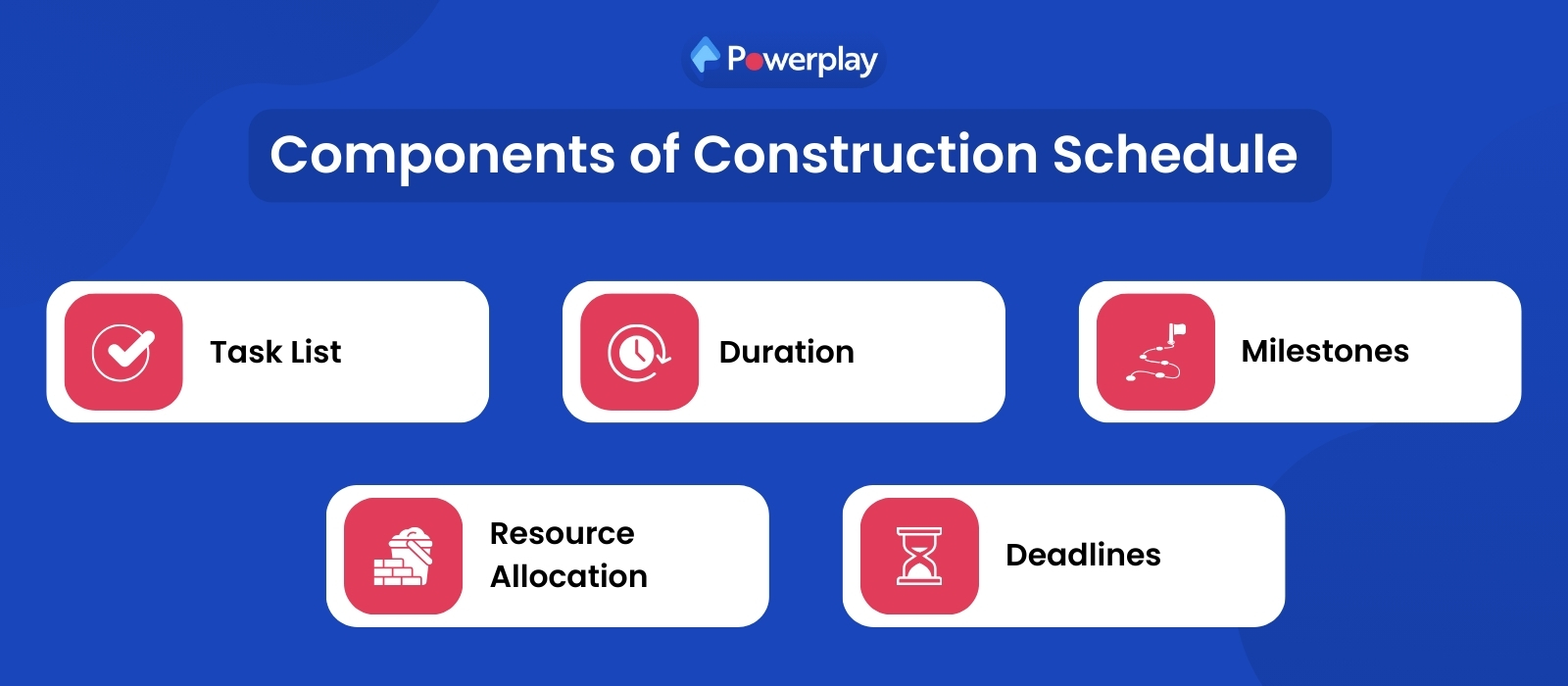
- Task List: A breakdown of all tasks and activities required to complete the project, often detailed enough to include every phase from groundbreaking to final inspections.
- Duration: The estimated time each task will take to complete.
- Dependencies: The relationships between tasks, showing which tasks must be completed before others can start, facilitating the identification of the critical path.
- Milestones: Key dates by which certain aspects of the project need to be completed, often linked to payments, regulatory approvals, or the start of a subsequent phase.
- Resource Allocation: Details about the labour, equipment, and materials needed for each task, ensuring that resources are available when required to avoid delays.
- Deadlines: Specific completion dates for the project or project phases, which client needs or contractual obligations may dictate.
Construction Scheduling Basics
Construction scheduling is essential in ensuring projects are completed on time and within budget, and it includes various basic steps which need to be followed to manage the project more effectively and seamlessly.
Here are some fundamental points about construction scheduling basics:
- Project Milestones: Key stages in the project timeline indicating significant achievements.
- Duration: Time required to complete each task, measured in workdays or calendar days.
- Dependencies: Connections between tasks where one task’s initiation or completion depends on another.
- Lead and Lag Time: Lead time is the advance initiation of a task before another begins or completes, while lag time is the necessary delay after a task before the next can start.
- Float (Slack): The allowable delay for a task without impacting the overall project deadline.
- Resource Allocation: The assignment and management of resources such as labor, materials, and equipment for specific tasks.
- Baseline Schedule: The initially approved project schedule can only be altered through formal change procedures.
Construction Schedule vs. Schedule of Works
The construction schedule is integral for overall project timing and management, while the Schedule of Works is crucial for detailing the work to be carried out and its specifications. And here are the key differences between a Construction Schedule and a Schedule of work:
| Aspect | Construction Schedule | Schedule of Works |
| Purpose | Provides a detailed timeline for the entire project, including start and finish dates for all activities. | Details the work items that need to be completed, often without detailed timing. |
| Content | Includes all tasks, durations, dependencies, resources, and milestones. | Lists specific tasks or work packages, typically with specifications and quantities, but with less focus on timing. |
| Focus | Emphasises time management and project phases. | Focuses on the description and scope of work to be done. |
| Use | Used by managers to track progress and manage deadlines. | Used by contractors to understand the scope and requirements of each task. |
| Detail | Very detailed in terms of timing and sequence of operations. | More detailed in technical specifications and execution standards but less detailed in scheduling. |
| Visualisation | Often visualised as a Gantt chart showing the timeline. | Typically presented as a list or table in contract documents. |
| Update Frequency | Updated frequently to reflect real-time project changes and delays. | Updated as needed, primarily if there are changes in the scope or specifications of the work. |
| Stakeholders | Used by all stakeholders for monitoring project progress. | Primarily used by on-site workers, subcontractors, and supervisors to guide daily operations. |
5 Steps to Make a Construction Schedule
Creating a robust construction schedule involves several crucial steps to make sure the project runs smoothly and efficiently. Here are five important steps to make a construction schedule:

Step 1 – Gather Information About Project Requirements:
Start by collecting detailed information about the project, including its scope, requirements, and any special considerations that must be accounted for. This includes understanding the functions the building will serve, the specialisations required, and how many visitors or users it needs to accommodate.
Step 2 – Choose Your Scheduling Technique
Select the most appropriate scheduling technique for your project. Options include Gantt charts, Critical Path Method, Line of Balance, and Resource-Oriented Scheduling, each suitable for different projects and objectives.
Step 3 – Identify and Prioritise Project Tasks
Break down the project into smaller tasks and prioritise them. This could involve considering the cost, customer requirements, and available resources to determine how tasks should be tackled. It’s crucial to identify dependencies between tasks at this stage.
Step 4 – Estimate Task Duration and Develop the Timeline
Assign realistic start and finish dates to each task, considering weather, resource availability, and legal holidays. This helps create a timeline that reflects the true scope of the project.
Step 5 – Choose an Appropriate Construction Scheduling Tool
Use a construction scheduling tool that fits your project’s needs. Modern tools like Gantt chart software can help organise tasks, set dependencies, and visualise the schedule, making adjustments easier as the project progresses.
Principles of Construction Scheduling
Construction scheduling principles are fundamental guidelines that ensure the efficient management of time, resources, and tasks throughout a construction project. Following these principles will ensure that the projects are on track and are completed within the budget.
Let’s explore each of the construction scheduling principles in detail:
-
Work Breakdown Structure (WBS)
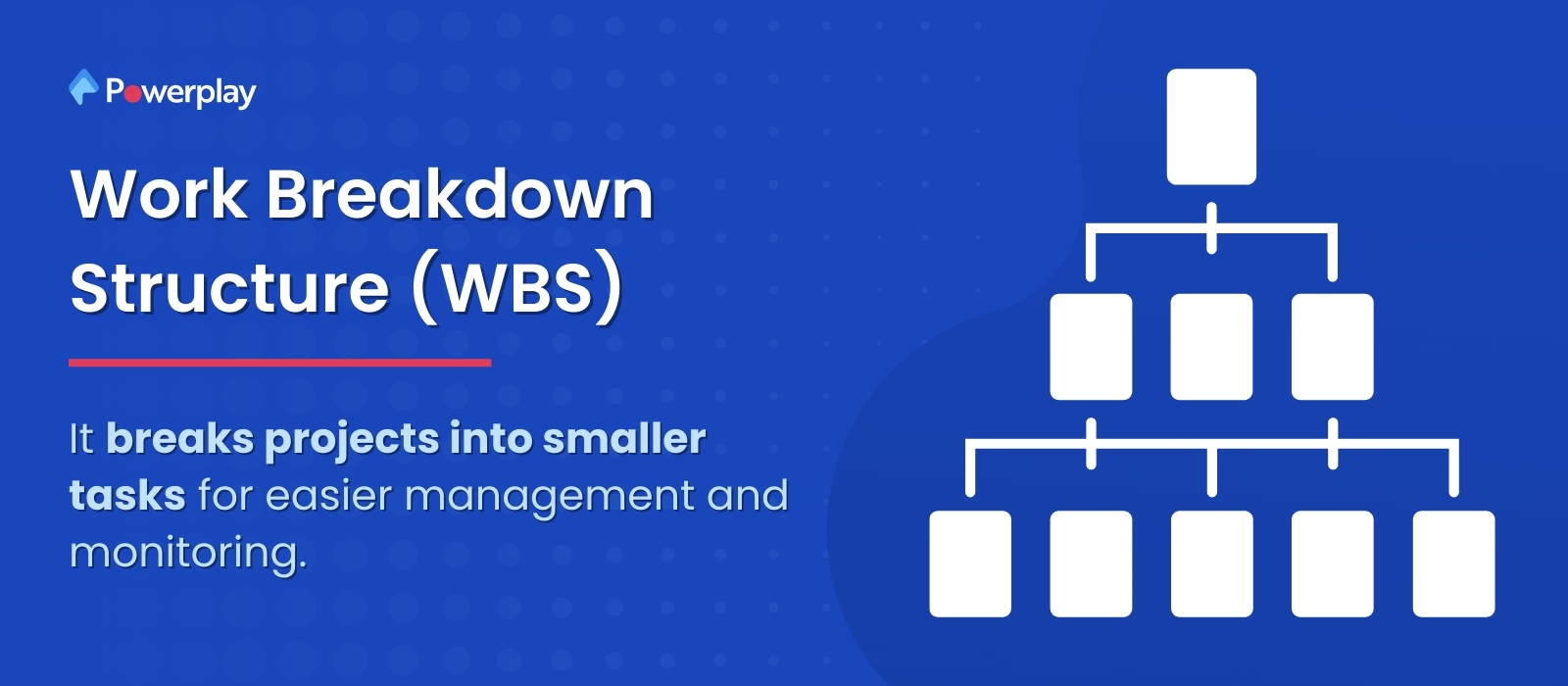
The Work Breakdown Structure is a foundational project management technique that breaks a project into smaller, more manageable components or tasks. This hierarchical breakdown allows for easier management and monitoring.
Each level of the WBS provides progressively detailed definitions of the project components, ensuring that nothing is overlooked and facilitating resource and responsibility allocation.
-
The Critical Path

The critical path method (CPM) is a step in construction scheduling that identifies the sequence of crucial, dependent tasks that determine the longest path through the project schedule. Tasks on the critical path will not be delayed without affecting the project’s overall timeline, making them essential to monitor closely. Managing the critical path ensures the project is completed in the shortest possible time.
-
Resource Allocation
Effective resource allocation involves ensuring that the necessary resources (labour, materials, equipment, and budget) are available at the right times throughout the project. Proper allocation prevents delays and overallocation, which can lead to project inefficiencies and increased costs. This principle is about optimising the use of resources to maintain a steady workflow and meet the project timeline.
-
Risk Assessment

Risk assessment in construction scheduling involves identifying potential risks and their impacts on the project timeline. This includes forecasting possible delays due to material shortages, labour issues, equipment failures, or unforeseen events like weather conditions.
Proactive risk assessment helps develop contingency plans, thus minimising the impact of risks on the project schedule.
-
Continuous Monitoring
Continuous monitoring is crucial for the successful execution of a project schedule. It involves regularly checking the project’s progress against the schedule, adjusting tasks and resources as needed, and responding to any issues.
This principle ensures that the project stays on track and allows changes to be made promptly to address any deviations from the planned schedule.
Visualising Construction Schedules
Visualising construction schedules is essential for effective project management, as it provides clear and actionable insights into project tasks’ timing, sequencing, and progress. It includes different visualisation techniques, such as Gantt charts, network diagrams, and 3D models with scheduling data, which help depict various aspects of the project timeline and resource allocation.
Gantt Charts
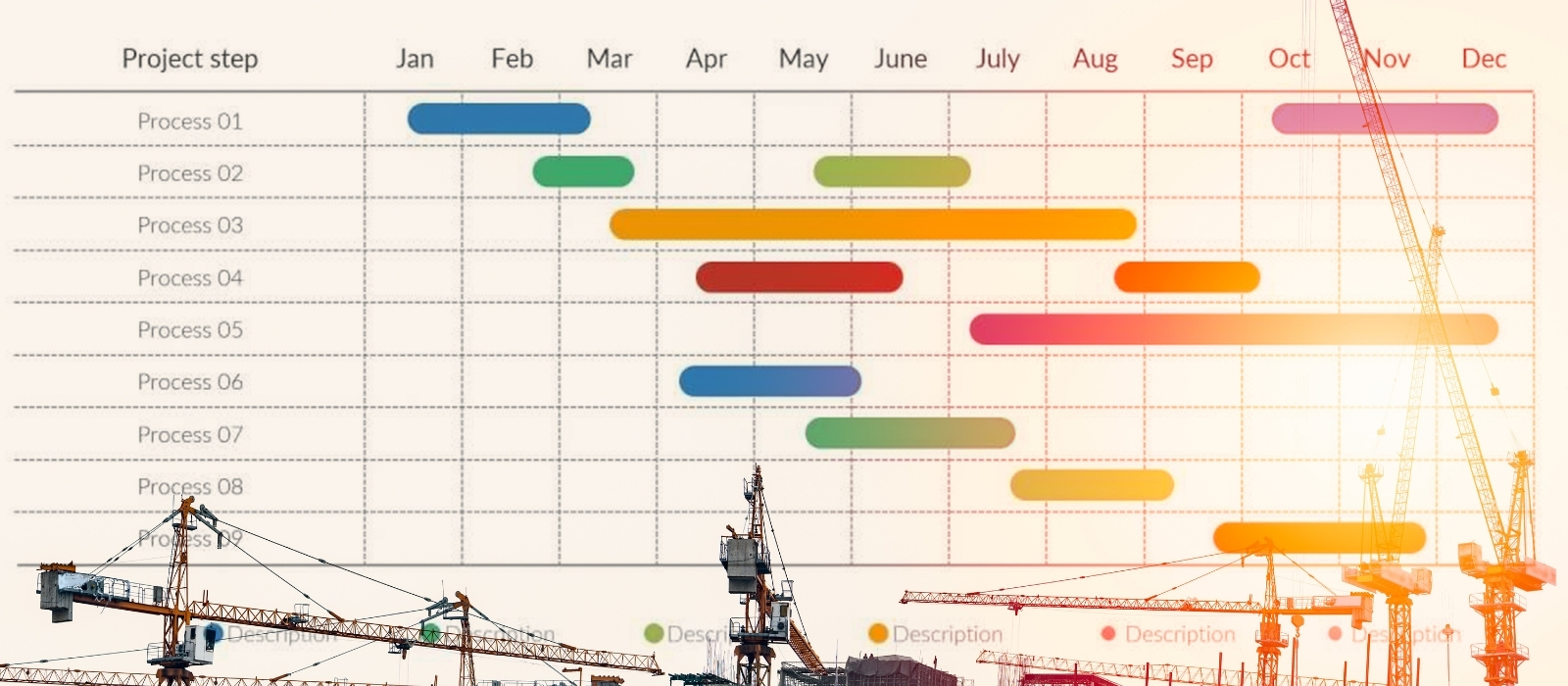
Gantt charts are tools which you can use to visualise project schedules. They display the project timeline on a horizontal axis, with each task as a bar spanning from its start to end date. This visualisation helps understand task durations, dependencies, and overlaps, making tracking progress and managing deadlines easier.
Network Diagrams
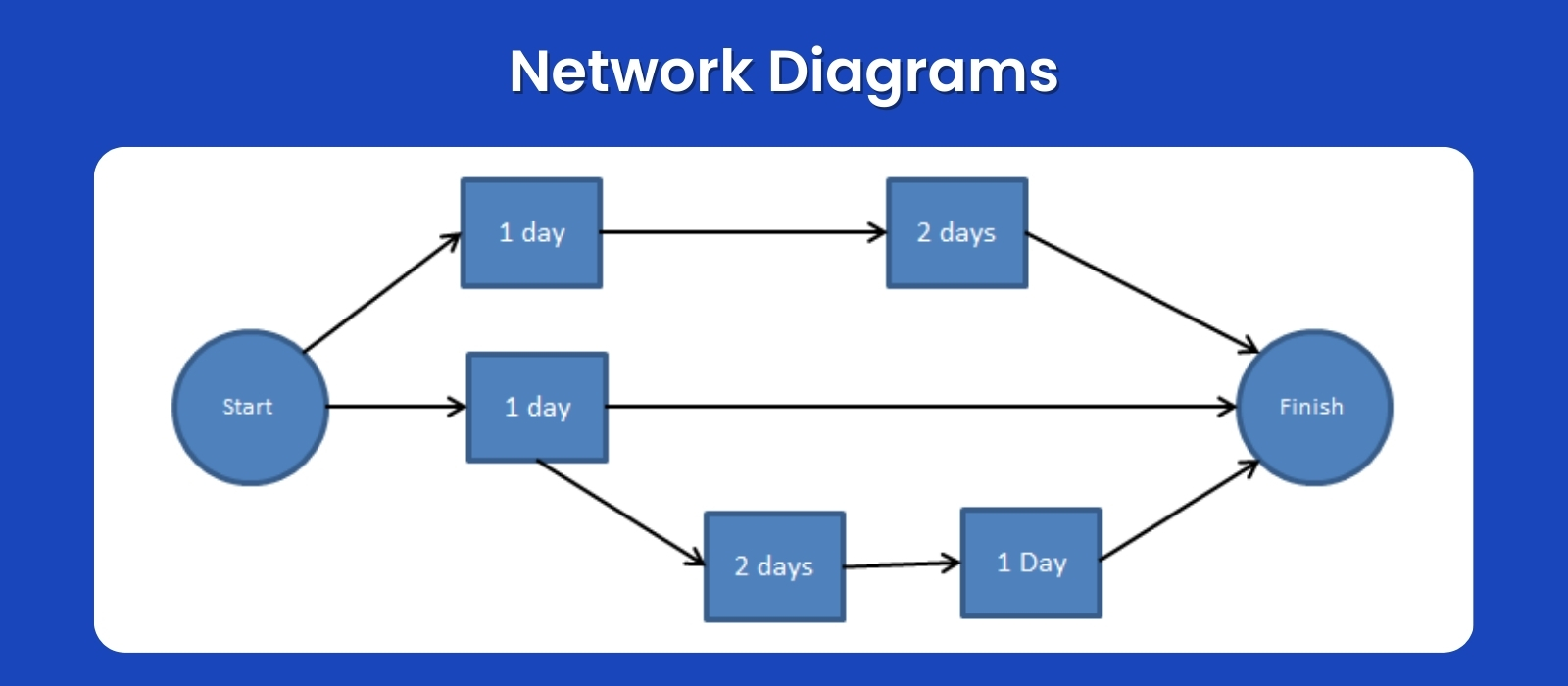
Network diagrams, also known as PERT (Program Evaluation and Review Technique) charts or critical path diagrams, illustrate the relationships and reliance between project tasks. They show how tasks sequence with each other, identifying critical paths and potential bottlenecks. This type of diagram is useful for complex projects where task interdependencies are significant.
3D Models With Scheduling Data (BIM 4D)

BIM (Building Information Modeling) 4D integrates, 3D physical models with time-related information, visualising the construction process over time. This allows stakeholders to simulate construction sequences, visualise spatial conflicts, and optimise the schedule before construction begins, improving overall project management and coordination.
Scheduling Methodologies
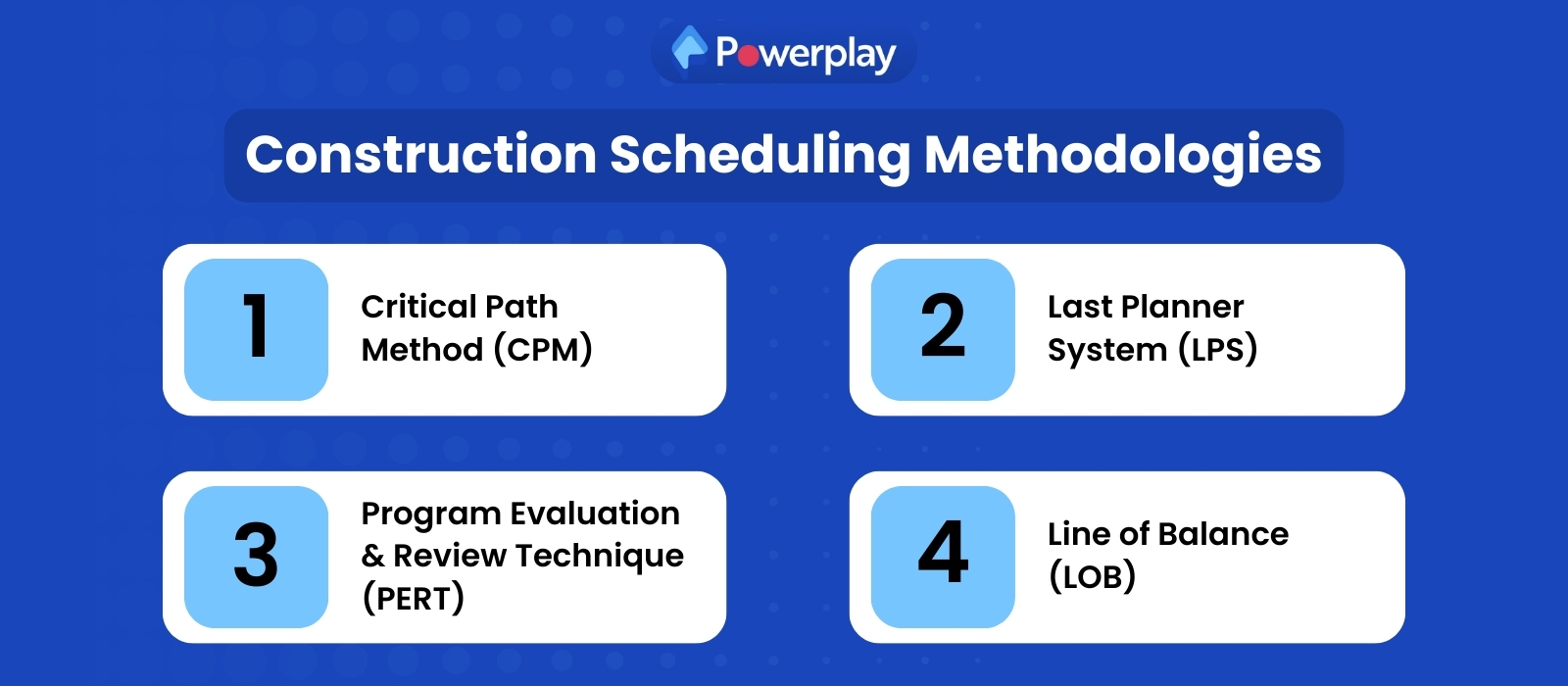
Scheduling methodologies are structured approaches used to plan, organise, and manage tasks and resources in a project, ensuring that it is finished efficiently and effectively within the designated timeline. These methodologies help by providing clear frameworks and techniques to guide the sequencing of tasks, allocation of resources, and management of dependencies. Here are a few methodologies which will help in effectively scheduling your projects:
Critical Path Method (CPM)
The Critical Path Method is a step-by-step project management technique for scheduling a set of project activities. It identifies the longest sequence of tasks in a project and determines the shortest possible duration.
Managing the tasks on this path is crucial because any delay in these tasks will directly extend the project’s overall duration. CPM is particularly useful for projects with complex interdependent activities.
Last Planner System (LPS)
The Last Planner System (LPS) is a collaborative approach to production control in construction projects. Developed by the Lean Construction Institute, it aims to improve project scheduling predictability and execution efficiency.
It involves team members at various levels, from project managers to foremen, in planning, emphasising commitment and accountability. The method enhances workflow reliability and ensures work progresses as planned, reducing waste and maximising value.
Program Evaluation and Review Technique (PERT)
PERT is a statistical tool used to analyse the tasks involved in finishing a project, the time needed to finish each task, and to find the minimum time needed to complete the total project.
It involves creating a project network diagram that includes all the tasks, their durations, and dependencies, allowing for recognising the critical path. This methodology is particularly beneficial for projects where time is a critical factor, and the tasks involve a degree of uncertainty.
Line of Balance (LOB)
Line of Balance is a management control process used in construction, manufacturing, and other industries that involve repetitive work processes. This methodology is especially useful for projects requiring repeated tasks at multiple locations or stages, such as high-rise buildings or pipelines.
LOB visualises the progress of these repeating tasks across different units or locations, helping to ensure that work progresses smoothly and systematically. It effectively manages the flow of resources and optimises the sequence of operations to prevent scheduling conflicts and delays.
Scheduling Challenges
Effective scheduling is vital for the success of any construction project, but it often encounters various challenges. Here are some of the most common challenges that every owner needs to know about:
Resource Constraints:
Projects often face limitations in terms of labour, materials, and equipment, which can lead to delays and disruptions in the schedule. Resource shortages, such as a lack of skilled workers or material supply issues, can significantly impact project timelines.
Weather Conditions:
Outdoor construction projects are particularly vulnerable to weather conditions, which can cause unexpected delays. Adverse weather, such as rain, snow, or extreme temperatures, can halt construction activities, making it difficult to adhere to the planned schedule.
Scope Creep:
Scope creep refers to changes that are uncontrolled or continuous growth in a project’s scope, often without adjustments to time, cost, and resources. As the project expands beyond its original parameters, it can lead to extended timelines and additional costs.
Coordination and Communication Issues:
Strong communication and coordination among contractors, subcontractors, suppliers, and clients are essential for maintaining a schedule. Miscommunication or poor coordination can lead to inefficiencies and conflicts that disrupt the workflow and delay the project.
Regulatory and Permit Delays:
Obtaining required permits and ensuring compliance with local, state, and federal regulations can be time-consuming. Delays in receiving approvals or last-minute changes to regulations can stall projects, affecting the overall schedule.
Strategies to Mitigate Scheduling Problems
Effective scheduling management is crucial to avoiding delays and cost overruns. To address the various challenges that can disrupt timelines, project managers can implement several strategic practices that enhance flexibility and responsiveness throughout the project lifecycle.
Here are a few strategies to mitigate scheduling problems in construction projects:
- Implementing sophisticated project management software can help create flexible and accurate schedules, allow quick adjustments, and better track project milestones.
- Conducting frequent progress meetings with all project stakeholders ensures issues identification of issue to address them promptly, and helps to keeping the project on track.
- Proactively identify potential scheduling risks and develop contingency plans to address them, reducing the impact of unexpected delays.
- Maintain a flexible approach to resource allocation, with buffer resources available to handle sudden demands or delays in the project timeline.
How to Create a Construction Schedule With Powerplay
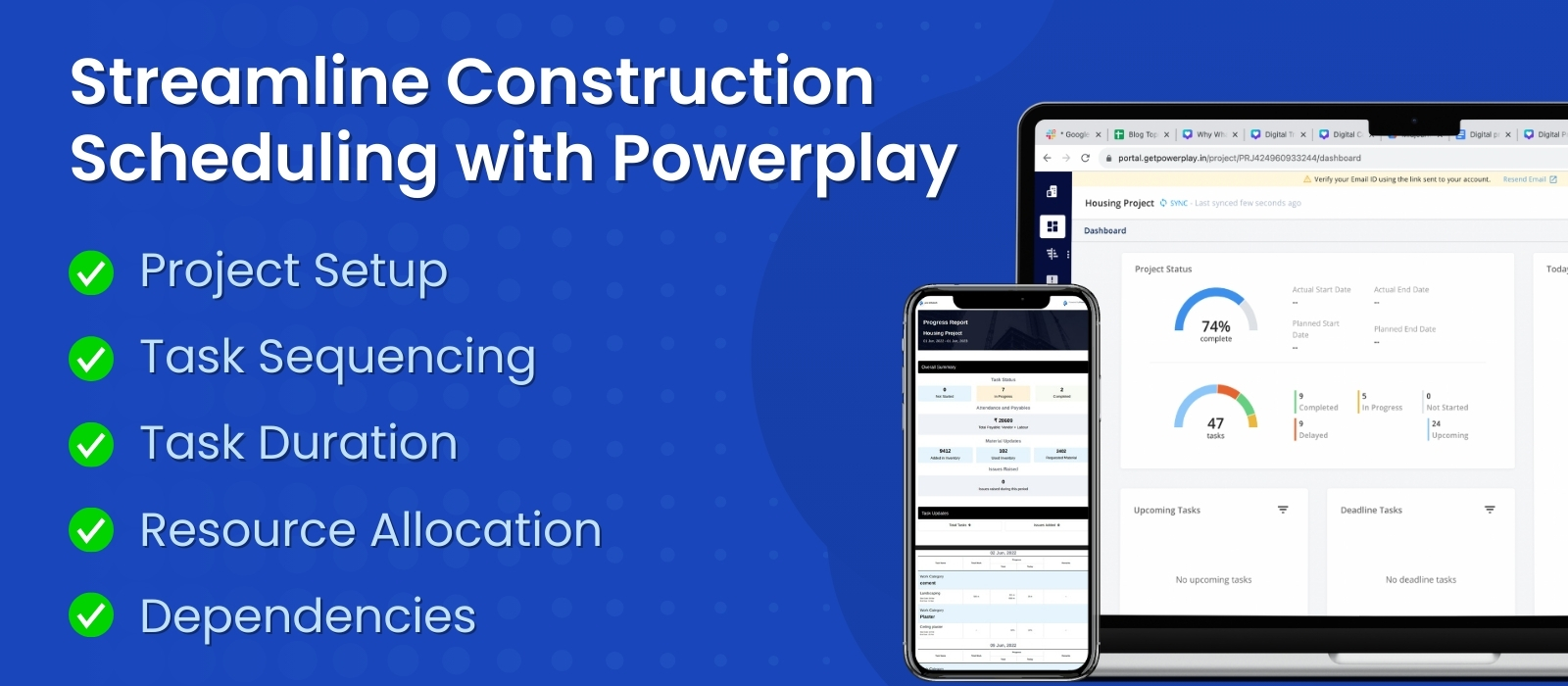
Creating a construction schedule with the Powerplay construction management app is a straightforward process. Follow these steps to get start:
Project Setup: Begin by setting up your project using the Powerplay app. Provide essential project details such as project name, location, start date, and project duration.
Task Breakdown: Break down your project into smaller, manageable tasks. List all the tasks necessary for project completion, including site preparation, foundation work, framing, electrical installation, plumbing, etc. Then, break down the work into main tasks and subtasks.
Task Sequencing: Determine the sequence in which tasks need to be completed. Some tasks may depend on others, so ensure they are sequenced accordingly to avoid delays. Make sure to include the baseline in the project to track both estimated and actual progress. This baseline serves as a reference point against which you can compare the planned schedule with the actual progress of the project.
Task Duration: Estimate the duration for each task. This can be based on historical data, industry standards, or input from your team members. Be realistic in your estimates to ensure accuracy. Incorporate the duration for subtasks within each main task, ensuring accurate reflection of modifications through the integrated Critical Path Method (CPM) functionality embedded in the software.
Resource Allocation: Assign and track labour (skilled and unskilled), machinery, subcontractors, and materials to each task, ensuring availability per the schedule to prevent bottlenecks and delays. Utilise the inventory tracking feature to manage stock levels, facilitate site-to-site transfers, and digitally create and track goods receipt notes (GRNs) and purchase orders (POs) seamlessly, eliminating the risk of missing site data.
Dependencies: Identify any task dependencies, such as tasks that cannot start until others are completed. Use this information to create a logical sequence of tasks and ensure smooth workflow.
Conclusion
Mastering construction scheduling is essential for the successful delivery of any project. Knowing all the techniques will help project managers effectively plan, execute, and monitor construction activities to ensure timely completion. Construction professionals can significantly enhance project outcomes by understanding the principles of scheduling. And utilising powerful tools like Powerplay, and adopting proactive strategies to mitigate potential problems.
Embracing these practices will improve efficiency and productivity and reduce costs and delays, leading to greater satisfaction for all stakeholders involved.
